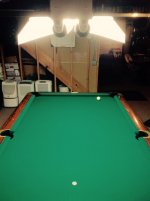Before you spend a ton of money on alternate solutions:
- Make sure that the height of your light (to the bottom of the shades) is 38-42" from the surface of the slate. Higher is better, but you don't want to go so high that the light is blinding, as you walk around the table.
- Use high wattage (100W equivalent) 6500K LED bulbs





